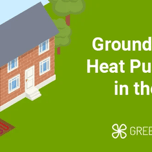Answer these simple questions and we will find you the BEST prices
Which type of solar quotes do you need?
It only takes 30 seconds
100% free with no obligation

You need to fill in only 1 form to get free quotes

We call you to confirm your enquiry

Receive quotes from local installers
- GreenMatch
- Blog
- A Guide to Geothermal HVAC
A Guide to Geothermal HVAC
A geothermal HVAC is a very versatile device, since it can provide a building with heating, cooling and even hot water with, at least, the same quality conditions than conventional systems commonly used for these purposes. That is, it can function as a furnace, an air conditioner and a water heater (it only replaces completely a water heater in summer) all together.
The practicality of replacing two different equipments (a conventional water heater would still be necessary) by just one could be enough reason for a homeowner to consider it a smart move. But there’s more. A geothermal HVAC can also save considerable amounts of both energy and money thanks to its high efficiency (300% to 500% when heating) and due to the fact that its primary source of energy is completely free. We are referring to (low grade) geothermal energy, that, in addition to the saving benefit, is a renewable and clean source of energy.
Lastly, we should notice that the use of geothermal technologies allows HVAC systems to improve comfort by almost eliminating noise and improving temperature and humidity control, and to give the homeowner a 50% to 75% of independence from external energy sources (electricity represents the remaining 25% to 50%). If you want to request offers, just fill in the form on the right. It's free and without obligations.

About HVAC
HVAC is a climate control technology that supplies thermal comfort (by basically controlling temperature and humidity -mostly involving heating and cooling-) and indoor air quality (by frequently replacing indoor air -involving ventilating-, among other measures). It is the acronym for heating, ventilating and air conditioning. It is important to emphasise that these three operations are closely interrelated and that it is not possible to provide the indoor thermal properties required on a specific building by using only one of them.
The core components of a HVAC system are the geothermal unit and the distribution system. The geothermal unit is responsible for transferring heat from one space to another. The distribution system spreads the energy provided by the geothermal unit throughout the building.
The geothermal unit functionality can be performed by a wide range of technologies, from the combustion of fuels (oil, natural gas, coal or propane) or the use of an electrical resistance to the typical cyclic process of a heat pump. A heat pump system is the one employed at geothermal HVAC. It transfers heat between the inside of the building and a source of energy (that could be taken from external air, the ground…).
In our particular case, the source of energy is solar energy stored in the Earth’s crust (called low grade geothermal energy). The elements that compose a heat pump are the compressor (where electric energy is used to heat the working fluid), the condenser (here the working fluid transfers heat), the expansion valve and the evaporator (the working fluid draws heat). One of the main particularities of heat pumps is that the cycle can be reversed (by means of a reversing valve), allowing for heating and cooling.
The distribution system also accepts different kinds of configurations. The most commonly used for geothermal HVAC is the forced-air/ductwork typically employed for air conditioning. Other successful options for heat distribution are radiators, radiant floors, fan coils and baseboard heaters.
For the purpose of obtaining hot water from the HVAC system, a “desuperheater” can be added to the heat pump. It is a device that heats household water that circulates through the regular piping system. In cooling periods (summer), the heat removed from the building heats water thanks to the “desuperheater”, matching the whole demand of it, and, thus, making it completely free.
In heating periods (winter), the excess of heat collected is used the same way, allowing for a reduction in water heating spending of 50% during those periods, being the remaining hot water demand covered by the regular water heater. During spring and autumn, when the heat pump may not be working at all, the regular water heater is utilized.

HVAC Powered by Geothermal Energy
What distinguishes a geothermal HVAC from any other type of HVAC system is its power source: the earth. Within geothermal energy it is possible to consider two different kinds on the basis of their ultimate power source. They are high grade and low grade geothermal energy.
High grade geothermal energy is heat produced by the earth’s pressure, that transforms underground water into vapour. Low grade geothermal energy is solar energy stored in the Earth crust’s. Low grade geothermal energy is the one harnessed by a geothermal HVAC. For this reason, the term “geothermal” is used in this page referring exclusively to low grade geothermal energy.
The part of the geothermal HVAC that collects energy from (or releases it in) the ground is called ground loop. These are installed either horizontally or vertically, with the latter requiring ground source heat pump boreholes.
Diverse configurations can be applied, but all of them follow the same principle: the exchange of heat between a fluid (water with refrigerant and/or some chemicals) and the ground (or a pond, lake or water well). Those configurations can be classified into open and closed loops.
Open loops take water from an aquifer and discharge it after the heat has been transferred to the building. They are not permitted everywhere (in some regions or even countries regulations don’t allow this kind of technology to be used) and they are less common than closed loop systems.
Closed loops consist of a continuous net of pipes buried underground where a mix of water and a refrigerant circulates.
If you are interested in geothermal HVAC systems, we provide you with a tool where you'll be able to request offers from different supplyers and to compare them accordingly to your own preferencies. You just have to fill in the form on the top right on the page. It's free and without obligations and it will only take few minutes.
We strive to connect our customers with the right product and supplier. Would you like to be part of GreenMatch?




